
We may earn a commission from the affiliate links on this site. Learn more›
The Roland TD-17KVX is the best mid-level entry to V-drum kits, hands down.
I’ve sung my praises towards Roland in other articles. They make excellent electronic drums and never shy away from the high-end player.
The Roland TD-17KVX is no different. While the pad sizes are a little on the smaller side, the value outweighs this tiny con.
Today we will have an in-depth look into the TD-17KVX and help you determine if it’s the right electronic drum set for you.
Roland TD-17 Overview
The TD-17 electronic drum set comes in three variants — the TD-17KL, TD-17KV, and TD-17KVX.
All three kits are five-pieces and utilize the TD-17 drum module as the name implies. For the purposes of this article, I will primarily be discussing the KV and KVX only, as I’m not big on the KL.
Roland’s naming schemes tend to be a little complicated, so think of these three kits as basic, standard, and premium, in that order.
Which kit you choose determines whether you get mesh heads, a better and larger snare drum pad, a stand-mounted hi-hat, and an extra cymbal.
The TD-17KL isn’t worth it, in my opinion. The rubber pads are outdated when compared to other options on the market. Most kits today have mesh heads.
If you’re interested in the TD-17, I’d at least start with the KV. If the price is a little steep, have a look at some of Alesis’s intermediate e kit models.
For this article, I’m omitting the TD-17KL for the reasons laid out above.
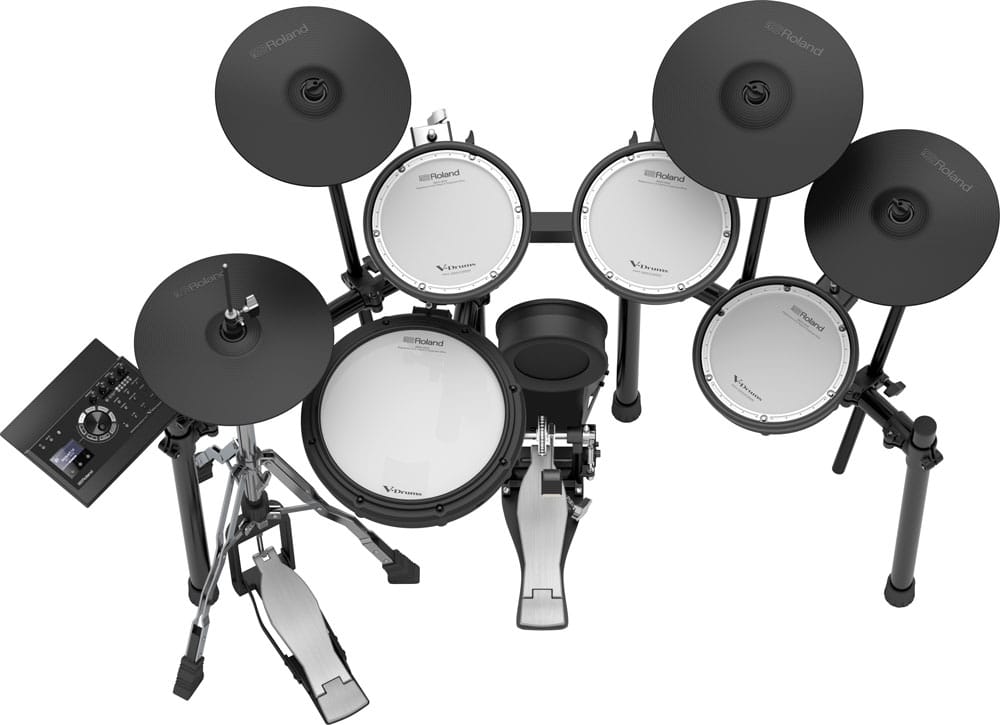
Both the KV and the KVX feature the larger PDX 12″ snare drum pad. The most significant difference between the two is the stand-mounted hi-hat pad and an additional ride cymbal.
The KVX also does feature two larger crash cymbals.
Aside from those differences, the kits are identical in every other regard.
The TD-17 Drum Module
One of the most prominent selling features of Roland e kits is their drum modules. The TD-17 is one of the best intermediate modules in this price range.
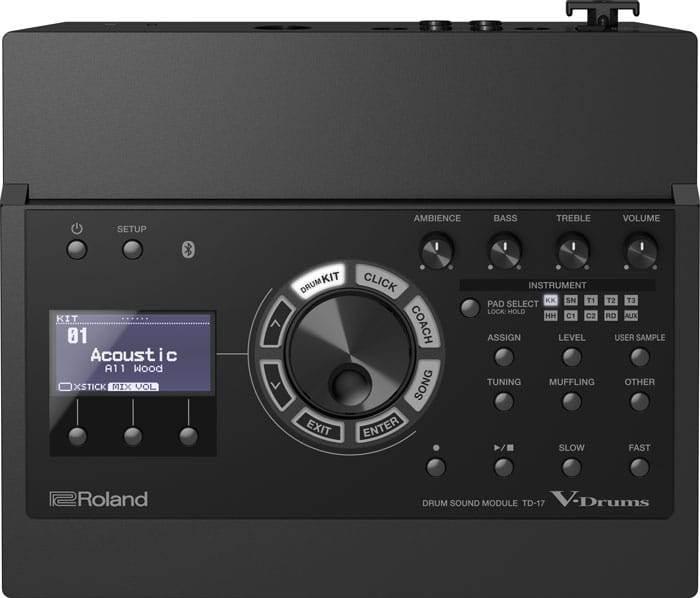
Roland includes 50 preset kits, and 310 drum/percussion sounds out of the box.
You can add WAV samples via SD/HC card. The TD-17 is the first module in the line of Roland drum modules to include this feature.
Another incredible feature? Stream and play along to your favorite songs via Bluetooth.
I can’t tell you how many times I’ve gone scavenging for a rogue auxiliary cable to plug in my iPhone to play along to some songs. This feature is a massive plus in my book.
The TD-17 features two additional 1/4″ dual-trigger inputs if you ever decide to add more pads in the future.
The 12″ PDX Snare Pad
At the core of every drum set is the snare drum. The PDX-12 snare pad allows for realistic buzz rolls and rim shots.
The 12″ size is very nice, making it feel much more realistic than some cheaper options on the market.
The two-play mesh head is tunable with a drum key so you can change the amount of bounce/rebound.
I wish the TD-17KV (and the TD-25KV) went one step further, offering actual drum shells like the Alesis Strike. I do understand that would add much more of a cost to the kit, but it would be nice.
I have a sneaking suspicion we may see something like the Strike shells on a new kit from Roland at NAMM 2020 (see my NAMM drums and percussion coverage here).
The Kick Tower
All three variants of the TD-17 utilize the KD-10 kick pad tower. The playing surface is small in diameter but will accept both single and double pedals.
The feedback while playing feels solid — it’s almost like a real bass drum head. The hardware frame reduces movement and minimizes sliding on rugs.
The Tom Pads
Roland has a solid reputation with sample pads and electronic percussion. The coveted “V-Drums” brand name is the holy grail of electronic drums and is a favorite toy of many instrument-shop goers.
The tom pads included are Roland PDX-8s. As the name implies, these are 8″ dual-zone triggers. The PDX-8 allows assignment of sounds to both the head and rim.
For example, the rim of your tom can have a clap sound, and the pad itself be an 808 sample.
I like the tom pads, but they’re a little small for my taste. I currently own the Alesis Strike kit, which features bigger tom pads, but the hi-hat is irredeemable — Roland wins every time in feel.
The Cymbal Pads
Roland generally sticks out with their cymbal pads, both in performance and looks. The KV and KVX feature different cymbal models.
TD-17KV Cymbals
Starting with the KV, you get two CY-8 cymbal pads. These cymbal pads are only dual-zone, meaning you only can play the edge and bow of the cymbal. You will miss out on the bell zone.
The hi-hat controller included with the KV isn’t my favorite, but it’s usable. I much prefer to have a stand-mounted pad. The CY-5 V-Hi-Hat has a 10″ playing surface and separate bow and edge zones.
The FD-9 foot controller works in conjunction with the CY-5. It’s smooth and quiet, so for those in playing drums in apartments, this might be a great option.
TD-17KVX Cymbals
The KVX also features dual-zone cymbals, but they’re a little larger — 12″ in diameter.
The additional ride cymbal pad is excellent. While it’s only 13″ in diameter, you do get three zones allowing for bow, edge, and bell samples.
As stated before, the KVX has a stand-mounted hi-hat pad. The VH-10 hi-hat requires a hi-hat stand (not included) and feels far more realistic than its non-mounted counterpart.
That said, it doesn’t have two pads as some other higher-end hi-hat controllers have. It’s one rubber pad and the control piece.
The Hardware Frame
The frame included with the TD-17 is the MDS-COM drum stand. It’s an all-black finish, and I’ll be honest, I don’t like the sizing of the center portion.
To me, it looks a little squished. That said, COM is short for Compact, and the TD-17 is a smaller electronic drum set.
One huge feature that I love is the ball joint tilters for the cymbals. These allow for far greater cymbal positioning.
Overall Thoughts on the TD-17KV and TD-17KVX
There are a lot of options for electronic drum sets on the market. Sifting through them all is often a challenge.
It’s part of the reason why I started this website — to help drummers pick the gear best suited for their needs.
And if you’re wondering, no, electronic drum sets do not feel the same as acoustic drums.
There is a significant difference between the two, so don’t expect this to feel like your noisy five-piece drum set sitting in the garage.
The TD-17KV and KVX are great kits, but they aren’t Roland’s best offering. Roland doesn’t sell cheap. You’re paying for some of the best equipment in the business.
If you can’t afford the TD-25 or TD-50, but still want that authentic V-Drums experience, the TD-17KVX may be a perfect option.
I can’t recommend either kit to beginning players on good faith, but if you have the budget and want to try out the drums, by all means, go ahead.
E kits have gotten so much better in the last decade.
And while the TD-17KV or KVX probably won’t deliver an authentic acoustic feel when compared to a real kit, it will be an absolute joy to play and practice your chops.
Images throughout courtesy of Roland.

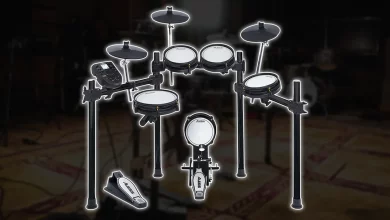
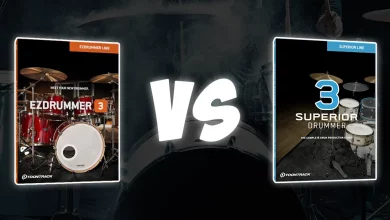
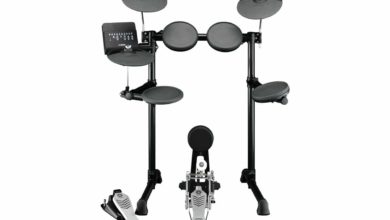
Hi. I have two questions. I bought a Roland TD-9 back in 2008, and I think most of its life is done. I’m curious how the KVX plays compared to that model?
Question 2: on my TD-9, I bought replacement pads on ebay, but their shelf life is already not resonating with hits after just 1-2 years replacing them. Will never buy used, second hand again. I’m not sure if it’s the cables or what, but I’m tired of doing surgery on the kit to try to fix the problems. I think they’re just done, and replacement pads aren’t cheap. Still, the module is fine, and cymbals all work fine, and frame is fully functional, as is kick pad. I’m wondering what I should with this half-usable kit? How can I make some money selling it while knowing it’s not a fully working kit – albeit, with some fully functioning parts?
0
Hi Nick,
If you like the feel of the mesh snare head, imagine those on the toms. I love having all mesh heads, but some people still like the feel of the rubber pads. It’s going to a somewhat similar (the size in particular), but I think the KVX is a major step-up from the older TD-9. Having the hi-hat on it’s own stand is a must for me. The module is impressive and features Bluetooth for playing along wirelessly (especially when most phones don’t feature a 3.5mm jack anymore).
Regarding question 2, I would hang on to any pads, parts, the module, etc… and use them as additional pads if desired. For example, I have an SPD-SX that I use with two additional Roland pads. Often times you can add additional pads to Roland modules. The TD-17, for example, features two additional 1/4″ dual-trigger inputs, so in theory, you could add two dual-zone pads or four single-zoned pads. I’m not entirely sure it would work with four, as I haven’t tried that.
If you want to sell it, you may need to tinker with it and try to fix it up to working order before selling it. Else, you’ll have to try to sell the pieces individually.
The biggest downside to the TD-17, though, is the fact that it uses a sub-snake pin cable for the module inputs (the part that looks like an old computer input). You must be familiar with that having used the TD-9. If one cable in the snake goes bad, you have to replace the entire cable for all the pads.
0